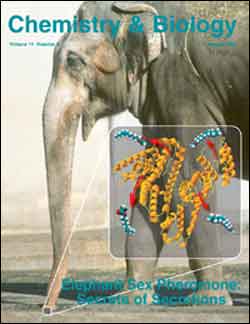Asian elephant sex pheromone transporter revealed

In this issue of Chemistry & Biology, Lazar and colleagues report an unexpected finding about pheromone transport in the Asian elephant, an endangered species of which only a few thousand individuals remain.
Female elephants communicate their readiness to mate by excreting a sex pheromone in their urine. Male elephants exhibit a range of responses to this pheromone, beginning with sniffing and “check and place” responses, where the male touches his trunk tip to the pheromone-loaded urine. Next, the male places the pheromone urine in his mouth, in a behavior known as flehmen, after which mating behavior typically ensues. The sex pheromone therefore has to travel through and survive a number of different environments, from serum to urine to mucus, for successful mating to occur. The authors have discovered that serum albumin, a ubiquitous vertebrate protein, plays an unexpected and multifaceted role as a shuttle that both protects and transports the pheromone. The authors reveal that elephant serum albumin (ESA) transports the pheromone from serum to urine and it extends the period of time that the pheromone remains available for detection in the environment, without actually masking the pheromone and hampering detection. Dissociation of the pheromone-ESA complex is induced by the low pH environment of the male elephant truck and enhances detection by producing a pulse of the volatile pheromone as the male elephant performs the characteristic flehmen behavior.
Use of albumin in urinary pheromone transport is distinct from other mammalian pheromone transport systems studied so far. Furthermore, the exploitation of albumin in pheromone transport complements the particular lifestyle of Asian elephants by reflecting the uniqueness of elephant anatomy, physiology, and behavior.
Media Contact
More Information:
http://www.cell.comAll latest news from the category: Life Sciences and Chemistry
Articles and reports from the Life Sciences and chemistry area deal with applied and basic research into modern biology, chemistry and human medicine.
Valuable information can be found on a range of life sciences fields including bacteriology, biochemistry, bionics, bioinformatics, biophysics, biotechnology, genetics, geobotany, human biology, marine biology, microbiology, molecular biology, cellular biology, zoology, bioinorganic chemistry, microchemistry and environmental chemistry.
Newest articles

Recovering phosphorus from sewage sludge ash
Chemical and heat treatment of sewage sludge can recover phosphorus in a process that could help address the problem of diminishing supplies of phosphorus ores. Valuable supplies of phosphorus could…

Efficient, sustainable and cost-effective hybrid energy storage system for modern power grids
EU project HyFlow: Over three years of research, the consortium of the EU project HyFlow has successfully developed a highly efficient, sustainable, and cost-effective hybrid energy storage system (HESS) that…

After 25 years, researchers uncover genetic cause of rare neurological disease
Some families call it a trial of faith. Others just call it a curse. The progressive neurological disease known as spinocerebellar ataxia 4 (SCA4) is a rare condition, but its…





















